IASbaba's Daily Current Affairs Analysis
Archives
(PRELIMS & MAINS Focus)
Syllabus
- Prelims – Geography
Context: The draft Geo-heritage Sites and Geo-relics (Preservation and Maintenance) Bill, 2022, while deemed necessary by several researchers, vests powers entirely in the Geological Survey of India (GSI), a 170-year-old organisation says experts.
About Geological Survey of India:
- The Geological Survey of India (GSI) is a scientific agency.
- It is one of the oldest of such organisations in the world and the second oldest survey in India after Survey of India (founded in 1767).
- GSI, headquartered at Kolkata, has six Regional offices located at Lucknow, Jaipur, Nagpur, Hyderabad, Shillong and Kolkata.
- Presently, Geological Survey of India is an attached office to the Ministry of Mines.
Evolution GSI:
- Until 1852, Geological Survey primarily remained focused on exploration for coal, mainly for powering steam transport, oil reserves, and ore deposits.
- Then Sir Thomas Oldham broadened the ambit of the scope of functioning of the Geological Survey of India to map the rock types, geological structures and relative ages of different rock types.
- In 19th and early 20th century GSI made important contributions to Seismology by its studies and detailed reports on numerous Indian earthquakes.
- In 2017 GSI began pilot project, with the first ever aerial survey of mineral stocks by GSI, to map the mineral stocks up to a depth of 20 km using specially-equipped aircraft.
Role of GSI:
- Conducting geological surveys and studies of India.
- Prime provider of basic earth science information to government, industry and general public
- Official participant in steel, coal, metals, cement, power industries and international geoscientific forums.
Restructuring of GSI:
- The GSI was restructured into 5 Missions on the basis of the Report of a High-level Committee chaired by Mr S. Vijay Kumar:
- Baseline Surveys
- Mineral resource Assessments
- Geoinformatics
- Multi-disciplinary Geosciences
- Training and Capacity Building
About Geo-heritage Sites and Geo-relics:
- The Geological Survey of India (GSI) declares geo-heritage sites/ national geological monuments for protection and maintenance.
- The draft bill defines Geoheritage sites as sites containing:
- geo-relics and phenomena,
- stratigraphic type sections,
- geological structures and geomorphic landforms including caves, natural rock-sculptures of national and international interest; and
- includes such portion of land adjoining the site.
- A Geo-relic is defined as any relic or material of a geological significance or interest like sediments, rocks, minerals, meteorite or fossils.
- The GSI will have the power to acquire geo-relics for its preservation and maintenance.
- The 32 geo-heritage sites spread across 13 states include:
- the Volcanogenic bedded Barytes of Mangampeta in Cuddapah district of Andhra Pradesh,
- the Akal Fossil Wood Park in Jaisalmer, Rajasthan etc.
Key provisions of the proposed bill:

- The Draft Geo-heritage Sites and Geo-relics (Preservation and Maintenance) Bill, 2022 vests powers entirely in the Geological Survey of India (GSI).
- The Bill give it the power to:
- declare sites as having ‘geo-heritage’ value,
- take possession of relics (fossils, rocks) that rest in private hands,
- prohibit construction 100 metres around such a site,
- penalise with fines up to ₹5 lakh and possibly imprisonment for vandalism, defacement, and violations of directives of a site by the Director General of GSI.
Declaration of geoheritage sites:
- It would authorise the Central Government to declare a geoheritage site to be of national importance.
- This would be under the provisions of the Right to Fair Compensation and Transparency in Land Acquisition, Rehabilitation and Resettlement Act, 2013 (RFCTLARR Act).
- Through a public notification in the Official Gazette, the government would spell out what areas were to be acquired by it.
Compensation:
- Provision is made for compensation to the owner or occupier of land who incurs loss or damage from the land due to the exercise of any power under this Act.
- The market value of any property will be ascertained in accordance with the principles set out in the RFCTLARR Act.
Prohibitions:
- The Bill imposes a prohibition on construction, reconstruction, repair or renovation of any building within the geoheritage site area or utilisation of such area in any other manner.
- Exception: construction for preservation and maintenance of geoheritage site or any public work essential to the public.
Penalties:
- There is a penalty of imprisonment which may extend to six months or fine which may extend to Rs.5 lakh, or both.
- In the case of a continuing contravention, additional fine of upto Rs.50,000 for every day of continuing contravention may be imposed.
Source: The Hindu
Previous Year Questions
Q.1) With reference to India, consider the following statements:
- Monazite is a source of rare earths.
- Monazite contains thorium.
- Monazite occurs naturally in the entire Indian coastal sands in India.
- In India, Government bodies only can process or export monazite.
Which of the statements given above are correct? (2022)
- 1, 2 and 3 only
- 1, 2 and 4 only
- 3 and 4 only
- 1, 2, 3 and 4
Q.2) Consider the following minerals:
- Bentonite
- Chromite
- Kyanite
- Sillimanite
In India, which of the above is/are officially designated as major minerals? (2020)
- 1 and 2 only
- 4 only
- 1 and 3 only
- 2, 3 and 4 only
Syllabus
- Prelims – International Relations
Context: On the sidelines of G20 presidency, India is planning to propose the launch of a global initiative to encourage the consumption and production of millets.
About Millet International Initiative for Research and Awareness (MIIRA):
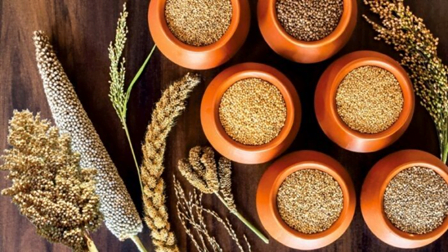
- It aims to connect the millet research organisations across the world while also supporting research on millet crops.
- Secretariat: Delhi, India
- It is in line with the UN declaring 2023 as the International Year of Millets and the Centre’s plan to make India a global hub for millets.
- 5 G20 meetings on agriculture:
- 3 of Agriculture Deputies,
- 1 of chief scientists, and
- 1 where the Agriculture Ministers of all G-20 countries will gather.
- It will be launched keeping in mind the nutritional value and the climate resilient nature of millets.
- It will set up a web platform to connect researchers and holding international research conferences.
- India will contribute the “seed money” while each G20 member will later have to contribute to its budget in the form of a membership fee.
Source: Indian Express
Previous Year Questions
Q.1) Among the following, which one is the least water-efficient crop? (2022)
- Sugarcane
- Sunflower
- Pearl millet
- Red gram
Q.2) With reference to pulse production in India, consider the following statements:
- Black gram can be cultivated as both kharif and rabi crops.
- Green-gram alone accounts for nearly half of pulse production.
- In the last three decades, while the production of kharif pulses has increased, the production of rabi pulses has decreased.
Which of the statements given above is/are correct? (2021)
- 1 only
- 2 and 3 only
- 2 only
- 1, 2 and 3
Syllabus
- Prelims – Science and Technology
Context: Monitoring the evolution of the shapeshifting H5N1 virus can add to the preparedness against another potential pandemic.
About H5N1 virus/Bird Flue:

- Bird flu or avian influenza is a disease caused by avian influenza Type A viruses found naturally in wild birds worldwide.
- Avian influenza, or bird flu, is a highly contagious viral infection that primarily affects birds.
- Infrequently, the virus can infect mammals from birds, a phenomenon called spillover, and rarely can spread between mammals.
- This subtype has caused a number of human infections through close contact with infected birds or contaminated environments, and is often fatal.
- Recent reports of H5N1 spread between mammals raise concerns about its potential to cause a human pandemic if it were to spill over and become transmissible among humans.
- It can infect domestic poultry including chickens, ducks, turkeys, pigs, cats, and tigers.
Types of avian influenza:
- Avian Influenza type A viruses are classified based on two proteins on their surfaces – Hemagglutinin(HA) and Neuraminidase(NA).
- There are about 18 HA subtypes and 11 NA subtypes.
- Several combinations of these two proteins are possible e.g., H5N1, H7N2, H9N6, H17N10, etc.
Symptoms:
- A virus infections in humans have ranged from mild to severe influenza-like illness.
- Fever, cough, sore throat, muscle aches, nausea, abdominal pain, diarrhea, vomiting etc.
- Severe respiratory illness (e.g., shortness of breath, difficulty breathing, pneumonia, acute respiratory distress, viral pneumonia, respiratory failure).
- Neurologic changes (altered mental status, seizures).
Prevention of spillovers:
- Preventing H5N1 spillovers and outbreaks requires a combination of measures including:
- vaccination of poultry,
- safe disposal of dead birds,
- wearing personal protective equipment when handling birds,
- quarantine and culling of affected animals, and
- improved surveillance and monitoring of H5N1 in birds and other animals.
- molecular surveillance of H5N1
- Genome sequencing can be employed to monitor the emergence of new subtypes, and keep a close watch on mutations and virulence factors that may increase the ability to infect humans.
Source: The Hindu
Previous Year Questions
Q.1) In the context of vaccines manufactured to prevent COVID-19 pandemic, consider the following statements:
- The Serum Institute of India produced COVID-19 vaccine named Covishield using mRNA platform.
- Sputnik V vaccine is manufactured using vector based platform.
- COVAXIN is an inactivated pathogen based vaccine.
Which of the statements given above are correct? (2022)
- 1 and 2 only
- 2 and 3 only
- 1 and 3 only
- 1, 2 and 3
Q.2) Consider the following:
- Bacteria
- Fungi
- Virus
Which of the above can be cultured in an artificial/ synthetic medium? (2021)
- 1 and 2 only
- 2 and 3 only
- 1 and 3 only
- 1,2 and 3
Syllabus
- Prelims: Polity and Governance
Context: 80 custodial deaths in 5 years, Gujarat tops list; Maharashtra second at 76
What is Custodial death?
- Custodial death means the death of a person in custody whether of the police or judicial.
- Custodial Death is widely referred to as death that happens to a person who is under trial or has already been convicted of a crime.
Constitutional and Legal Provisions:
- Protection from torture is a fundamental right enshrined under Article 21 (Right to Life) of the Indian constitution.
- The right to counsel is also a fundamental right under Article 22(1) of the India constitution.
- Section 41 of Criminal Procedure Code (CrPC) was amended in 2009 to include safeguards under 41A, 41B, 41C and 41D, so that arrests and detentions for interrogation have reasonable grounds and documented procedures, arrests are made transparent to family, friends and public, and there is protection through legal representation.
Court judgements on Custodial deaths/ Custodial violence:
- In Inderjeet v. State of Uttar Pradesh (2014), the Supreme Court held that punishment which has an element of torture is unconstitutional.
- In Francis Coralie Mullin vs. The Administrator, Union (1981) the Supreme Court held that Article 21 includes the right to protection against torture.
- D K. Basu v. State of West Bengal (1997) guidelines were passed to try and secure two rights in the context of any state action — a right to life and a right to know.
- Some of the guidelines laid down in D K Basu judgement are:
- All officials must carry name tags and full identification
- Arrest memo must be prepared, containing all details regarding time and place of arrest, attested by one family member or respectable member of the locality.
- The location of arrest must be intimated to one family or next friend, details notified to the nearest legal aid organisation and arrestee must be made known of each right
- All such compliances must be recorded in the police register
- He must get periodical medical examination
- Inspection memo must be signed by the arrestee also and all such information must be centralised in a central police control room.
- Some of the guidelines laid down in D K Basu judgement are:
Source: The Indian Express.
Previous Year Questions
Q.1) With reference to India, consider the following statements:
- Judicial custody means an accused is in the custody of the concerned magistrate and such accused is locked up in police station, not in jail.
- During judicial custody, the police officer in charge of the case is not allowed to interrogate the suspect without the approval of the court.
Which of the statements given above is/are correct? (2021)
- 1 only
- 2 only
- Both 1 and 2
- Neither 1 nor 2
Q.2) With reference to India, consider the following statements:
- Government law officers and legal firms are recognized as advocates, but corporate lawyers and patent attorneys are excluded from recognition as advocates.
- Bar Councils have the power to lay down the rules relating to legal education and recognition of law colleges.
Which of the statements given above is/are correct? (2022)
- 1 only
- 2 only
- Both 1 and 2
- Neither 1 nor 2
Q.3) With reference to India, consider the following statements:
- When a prisoner makes out a sufficient case, parole cannot be denied to such prisoner because it becomes a matter of his/her right.
- State Governments have their own Prisoners Release on Parole Rules.
Which of the statements given above is/are correct? (2021)
- 1 only
- 2 only
- Both 1 and 2
- Neither 1 nor 2
Syllabus
- Prelims: Polity and Governance
Context: Allegation against Jharkhand Chief Minister for allegedly allocating a mining lease to himself when he was the mining and forest minister of Jharkhand, which violates Office of Profit norms
About Office of Profit:
- Definition: The office of profit has been interpreted as a position that brings to the office-holder some financial gain, remuneration or benefit. The amount of such profit is immaterial. However, The constitution does not explicitly define the phrase.
- Objective: The intent is to avoid the conflict of interests between the duties and interests of an elected member.
What constitutes an ‘Office of Profit’?
- The conditions has been evolved over decades with subsequent judicial pronouncements. Supreme Court has listed certain factors while considering ‘office of profit’:
- whether the government is the appointing authority
- whether the government has the power to terminate the appointment
- whether the government determines the remuneration
- what is the source of remuneration
- the power that comes with the position.
Constitutional provisions regarding ‘Office of Profit’
- Article 102 (1): A person shall be disqualified for being chosen as a member of either House of Parliament if he holds any office of profit under the Government of India or the Government of any State, other than an office declared by Parliament by law not to disqualify its holder.
- Article 191 (1): A person shall be disqualified for being chosen as, and for being, a member of the Legislative Assembly or Legislative Council of a State if he holds any office of profit under the Government of India or the Government of any State specified in the First Schedule, other than an office declared by the Legislature of the State by law not to disqualify its holder.
- Provisions of Articles 102(1)(e) and 191(1)(e) also protect a legislator occupying a government position if the office in question has been made immune to disqualification by law.
Statutory provisions related to ‘Office of Profit’
- Parliament has also enacted the Parliament (Prevention of Disqualification) Act, 1959, which has been amended several times to expand the exempted list.
- RPA Act, 1951: Clause 9A of the Act says that a person shall be disqualified if there is a contract involving him in the course of his trade or business with the appropriate Government for the supply of goods to or for the execution of any works undertaken by that Government.
Source: The Indian Express.
Previous Year Questions
Q.1) Consider the following statements: (2019)
- The Parliament (Prevention of Disqualification) Act, 1959 exempts several posts from disqualification on the grounds of ‘Office of Profit’.
- The above-mentioned Act was amended five times.
- The term ‘Office of Profit’ is well-defined in the Constitution of India.
Which of the statements given above is/are correct?
- 1 and 2 only
- 3 only
- 2 and 3 only
- 1, 2 and 3
Q.2) Consider the following statements:
- According to the Constitution of India, a person who is eligible to vote can be made a minister in a State for six months even if he/she is not a member of the Legislature of that State.
- According to the Representation of People Act, 1951, a person convicted of a criminal offence and sentenced to imprisonment for five years is permanently disqualified from contesting an election even after his release from prison.
Which of the statements given above is/are correct? (2020)
- 1 only
- 2only
- Both 1 and 2
- Neither 1 nor 2
Syllabus
- Prelims: Polity and Governance
Context: The Ministry of Electronics and IT (MeitY), is currently building a WhatsApp-based chatbot return appropriate responses to queries.
About Bhashini:
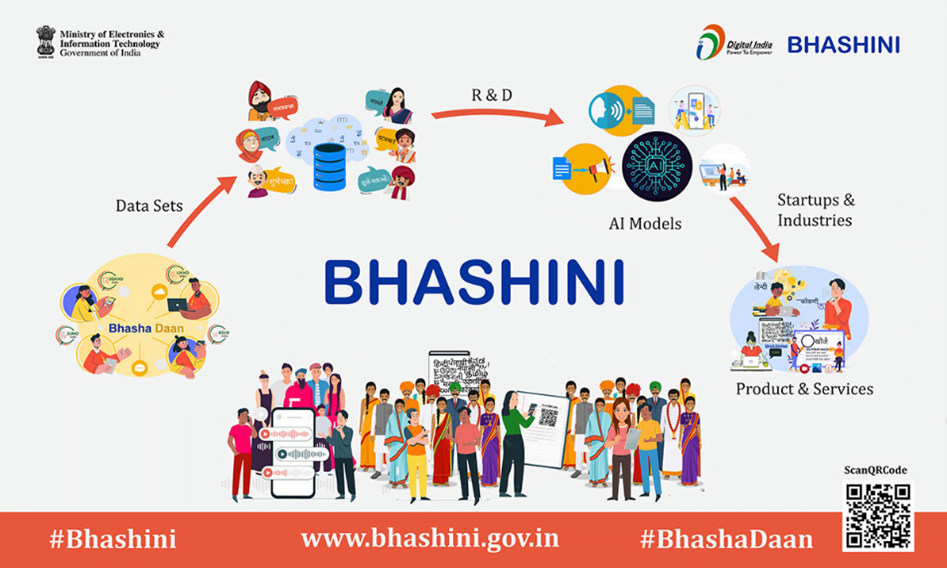
- It is India’s AI led language translation platform.
- It will make Artificial Intelligence (AI) and Natural Language Processing (NLP) resources available to MSMEs, Startups and Individual Innovators in the public domain.
- It will create and nurture an ecosystem involving Central/State government agencies and start-ups, working together to develop and deploy innovative products and services in Indian languages.
Aims and Objectives:
- It aims to increase the content in Indian languages on the Internet substantially in the domains of public interest, particularly, governance-and-policy, science and technology, etc. , thus will encourage citizens to use the Internet in their own language.
- It aims to build a National Public Digital Platform for languages to develop services and products for citizens by leveraging the power of artificial intelligence and other emerging technologies.
Source: The Indian Express.
Previous Year Question
Q.1) Which of the following is/are the aim/aims of “Digital India” Plan of the Government of India? (2018)
- Formation of India’s own Internet companies like China did.
- Establish a policy framework to encourage overseas multinational corporations that collect Big Data to build their large data centres within our national geographical boundaries.
- Connect many of our villages to the Internet and baring Wi-Fi to many of our schools, public places and major tourist centres.
Select the correct answer using the code given below:
- 1 and 2 only
- 3 only
- 2 and 3 only
- 1, 2 and 3
Q.2) Consider the following statements :
- Aadhaar metadata cannot be stored for more than three months.
- State cannot enter into any contract with private corporations for sharing of Aadhaar data.
- Aadhaar is mandatory for obtaining insurance products.
- Aadhaar is mandatory for getting benefits funded out of the Consolidated Fund of India.
Which of the statements given above is/are correct? (2020)
- 1 and 4 only
- 2 and 4 only
- 3 only
- 1, 2 and 3 only
Syllabus
- Prelims – Government Policies and Interventions
Context: Elimination of Lymphatic Filariasis: Karnataka starts mass drug administration in three high-transmission districts.
About Lymphatic Filariasis (LF):
- LF, commonly known as elephantiasis
- Considered as a Neglected Tropical Disease (NTD)
- Second most disabling disease after mental health.
- It impairs the lymphatic system and can lead to:
- the abnormal enlargement of body parts,
- causing pain,
- severe disability and social stigma.
- Lymphatic system is a network of vessels and specialized tissues that are essential to maintaining the overall fluid balance and health of organs and limbs and, importantly, are a major component of the body’s immune defense system.
- Lymphatic filariasis is a vector-borne disease,
- Caused by infection with parasites classified as nematodes (roundworms) of the family Filarioidea.
- There are 3 types of thread-like filarial worms which causes lymphatic filariasis:
- Wuchereria Bancrofti is responsible for 90% of the cases.
- Brugia Malayi causes most of the remainder of the cases.
- Brugia Timori also causes the disease.
Drug Treatment:
- The World Health Organization (WHO) recommends three drug treatments
- The treatment, known as IDA, involves a combination of: Ivermectin, diethylcarbamazine citrate and albendazole.
Scenario in India:
- An estimated 650 million Indians across 21 states and union territories are at risk of lymphatic filariasis.
- Over 40% of worldwide cases are found in India.
- The government launched the Accelerated Plan for Elimination of Lymphatic Filariasis (APELF) in 2018
Global Initiatives:
- Global Programme to Eliminate Lymphatic Filariasis (GPELF):
- WHO established the GPELF to stop transmission of infection with Mass Drug Administration (MDA) and to alleviate suffering among people affected by the disease through morbidity management and disability prevention (MMDP).
Source: The Hindu
Previous Year Questions
Q.1) Which one of the following statements best describes the role of B cells and T cells in the human body? (2022)
- They protect the body against the environmental allergens.
- They alleviate the body’s pain and inflammation.
- They act as immunosuppressants in the body.
- They protect the body from the diseases caused by pathogens.
Q.2) What is the importance of using Pneumococcal Conjugate Vaccines in India? (2020)
- These vaccines are effective against pneumonia as well as meningitis and sepsis.
- Dependence on antibiotics that are not effective against drug-resistant bacteria can be reduced.
- These vaccines have no side effects and cause no allergic reactions.
Select the correct answer using the code given below :
- 1 only
- 1 and 2 only
- 3 only
- 1, 2 and 3
Syllabus
- Prelims – Polity and Governance
Context: While addressing a summit in UP, PM recalled the tag of ‘BIMARU’, once used to describe the state.
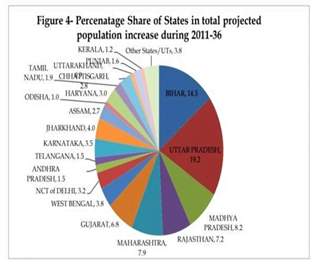
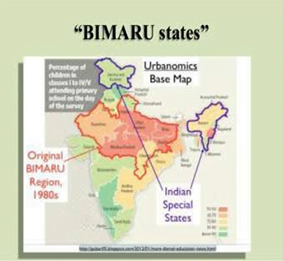
What do BIMARU states mean, who coined the term?
- BIMARU refers to a group of states in India, namely Bihar, Madhya Pradesh, Rajasthan, and Uttar Pradesh.
- The term was coined by the late demographer Ashish Bose in 1985 to highlight India’s demographic malady.
- Grouping was primarily based on their high population growth rates and a lack of progress in family planning and population control efforts.
- The term BIMARU means “sickly” in Hindi.
- Was used to refer to the slow rate of growth in terms of the economy, healthcare, education and other socio-economic characteristics.
- A 2020 report of the National Commission on Population of the Union Ministry of Health & Family Welfare, titled Report of the Technical Group on Population Projection, said BIMARU states will contribute to 49.1% of the population increase in India between 2011 and 2036.
- The literacy rates in these states according to the 2011 census against a National average of 74.04%., are:
- Bihar 63.8%,
- Rajasthan 67.1%,
- Jharkhand 67.6%,
- Madhya Pradesh 70.6% and
- Uttar Pradesh 71.7%
Source – Indian Express
Syllabus
- Prelims – International Relations
Context: The Minister for Communications recently inaugurated AMRITPEX 2023 in New Delhi.
About AMRITPEX:
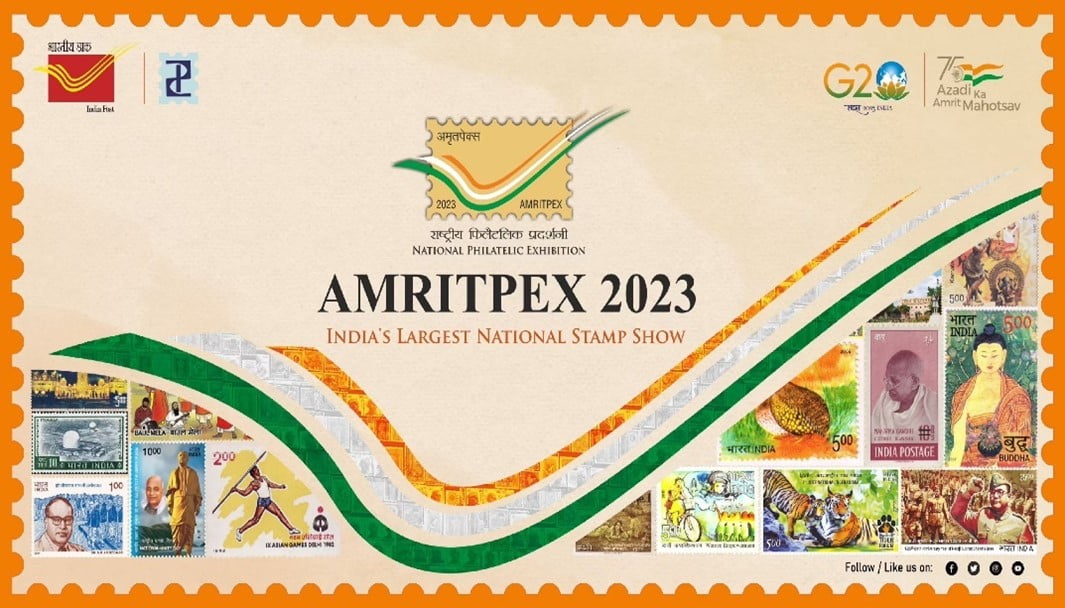
- AMRITPEX 2023 is a National Philatelic Exhibition Organized by the Department of Posts, Ministry of Communications and its stakeholders are the Ministry of Culture, Government of India, and the Philatelic Congress of India.
- Objective is to introduce Philately to the new generation, showcasing India’s History, Culture, Art, and Heritage through stamps and digital exhibits.
- Philately – The collection and study of postage stamps.
- The exhibition will feature a Wall of Philately, Mascot- VR Rooms, Digital Charkha, and Digital Kiosks.
- The exhibition’s themes include Azadi ka Amrit Mahotsav, Women Power, Youth Power, Nature and Wildlife, and Culture and History.
Source: PIB
Syllabus
- Mains – GS 2 (Governance) and GS 3 (Economy)
Context: India is on the fast track to promoting eco-friendly modes of transportation with a growing emphasis on hybrid and electric vehicles.
About Green Resolution:
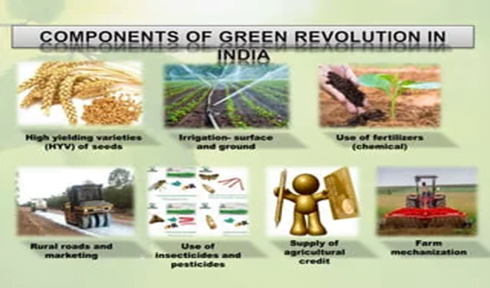
- The production of food within India was insufficient in the years from 1947 to 1960 as there was a growing population, during which famine was also anticipated.
- Many farmers were in debt, and they had become landless laborers.
- There was a severe shortage of food crops as well as commercial crops.
The Green Revolution:
- In India, the green revolution was launched under the guidance of geneticist Dr. M. S. Swaminathan.
- The Green Revolution was a period that began in the 1960s during which agriculture in India was converted into a modern industrial system by the adoption of technology, such as the use of high-yielding variety (HYV) seeds, mechanised farm tools, irrigation facilities, pesticides and fertilizers.
Primary aim:
- The green revolution’s primary aim was to introduce high-yielding varieties (HYVs) of cereals to alleviate poverty and malnutrition.
Benefits of Green Revolution
- There are undoubtedly positive effects on the overall food security in India.
- The Green Revolution within India led to an increase in agricultural production, especially in Haryana, Punjab, and Uttar Pradesh.
- Increased food production: The Green Revolution led to a considerable increase in food production, which helped in improving food security in India.
- Boosted economy: The movement helped to boost the Indian economy, with increased agricultural production contributing to economic growth.
- Reduced poverty: The Green Revolution in India contributed to a reduction in poverty, particularly in rural areas. Hence, it helped improve the standard of living for farmers.
- Increased employment opportunities: The revolution created new employment opportunities in agriculture and related industries, which helped tackle unemployment.
- Self-sufficiency: The Green Revolution helped India to become more self-sufficient in food production, reducing the country’s dependence on other countries for food.
- The green revolution led to the high productivity of crops through adapted measures, such as:
- Increased area under farming,
- Double-cropping, which includes planting two crops rather than one, annually,
- Adoption of HYV of seeds,
- Highly increased use of inorganic fertilizers and pesticides,
- Improved irrigation facilities, and
- Improved farm implements and crop protection measures.
Criticisms of Green Revolution:
Water-intensive crops:
- The crops introduced during the green revolution were water-intensive crops.
- About 3,500 litres of water is needed to produce one kg of rice, compared to 1,350 litres for wheat and 900 litres for maize.
- To take Punjab’s example, the state extracts 28 billion cubic metres (bcm) of groundwater annually, while its annual recharge is 19 bcm, which is unsustainable.
- Tube wells have to dive deeper and deeper to find water.
Imbalanced and unsuitable production:
- Punjab, Haryana and west Uttar Pradesh were chosen or led to produce wheat and rice for the nation.
- These states were relatively suitable for wheat, but not rice.
- The best states for rice were West Bengal, Odisha, Bihar and Assam.
- The three northern states were incentivized for growing rice along with wheat because they had good irrigation, unlike the eastern states which were largely rainfed.
Soil pollution:
- Chemicals have swallowed the soil’s innate nutrients.
- There has been a significant increase in the usage of pesticides, and India became one of the largest producers of pesticides in the whole of Asia.
Air pollution:
- Air pollution introduced due to the burning of agricultural waste is a big issue these days.
- In the heartland of the green revolution, Punjab, farmers are burning their land for sowing the crops for the next cycle instead of the traditionally practiced natural cycle.
Extinction of Indigenous Varieties of Crops:
- Since the time of the green revolution, there was reduced cultivation of indigenous varieties of rice, millets, lentils, etc.
- In turn, there was increased harvest of hybrid crops, which would grow faster.
- Due to the green revolution, India lost almost 1 lakh varieties of indigenous rice.
Health Impacts:
- Indiscriminate pesticide usage has led to several health effects in human beings in the nervous, endocrine, reproductive, and immune systems.
Way Forward:
- Crop Diversification:
- Agriculture in green revolution states cannot be saved unless a substantial part of rice cultivation is moved from there to eastern states.
- States want to diversify to other crops, but they do not want their income to fall in the process.
- It can be done only when the State builds robust ecosystems for alternative crops as it had done for rice and wheat.
- Climate-resistant crops:
- Addressing the challenges like water and air pollution would require agricultural production focussed on the water-energy nexus, making agriculture more climate resistant and environmentally sustainable.
- Technological interventions:
- Wider use of digital technology and extension services will be helpful in information sharing and generating awareness among the farmers.
- Need of Green Revolution 2.0:
- India needs a second green revolution along with the next generation of reforms with a view to make agriculture more climate-resistant and environmentally sustainable.
- Supply-side interventions:
- The need is supply-side interventions such as higher public investment, storage infrastructure and promotion of food processing.
Source: All India Radio
Practice MCQs
Q.1) Consider the following statements regarding Geological Survey of India:
- It is an attached office to the Ministry of Earth Sciences
- It declares geo-heritage sites/ national geological monuments for protection and maintenance
Which of the statements given above is/are correct?
- 1 only
- 2 only
- Both 1 and 2
- Neither 1 nor 2
Q.2) Consider the following statements regarding Office of Profit:
- It has been defined in the Constitution of India
- The Parliament (Prevention of Disqualification) Act, 1959 provides for statutory backup against office of profit
Which of the statements given above is/are correct?
- 1 only
- 2 only
- Both 1 and 2
- Neither 1 nor 2
Q.3) Consider the following statements regarding H5N1 disease:
- It is a disease caused by avian influenza Type A viruses
- Avian Influenza type A viruses are classified based on two proteins on their surfaces – Hemagglutinin(HA) and Neuraminidase(NA)
- It is a highly contagious viral infection that primarily affects birds.
Which of the statements given above is/are correct?
- 1 and 2 only
- 2 and 3 only
- 1 and 3 only
- 1 2 and 3
Comment the answers to the above questions in the comment section below!!
ANSWERS FOR ’ 14th February 2023 – Daily Practice MCQs’ will be updated along with tomorrow’s Daily Current Affairs.st
ANSWERS FOR 7th February – Daily Practice MCQs
Q.1) – b
Q.2) – c
Q.3) – b














